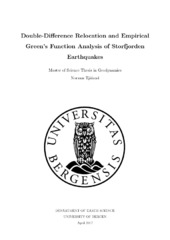Double-Difference Relocation and Empirical Green’s Function Analysis of Storfjorden Earthquakes
Master thesis
Permanent lenke
https://hdl.handle.net/1956/15947Utgivelsesdato
2017-06-08Metadata
Vis full innførselSamlinger
- Department of Earth Science [1050]
Sammendrag
On 21 February 2008, an earthquake of magnitude Mw 6.1 occurred in Storfjorden on Svalbard. Since then, more than 2000 earthquakes have been recorded in this region. More recently, on 29 March 2016, an earthquake of magnitude Mw 5.2 occurred close to Edgeøya. This event marks the north-eastern extension of the earthquake sequence. In this study, in order to improve the initial hypocenter locations, the double-difference relocation method has been applied to earthquakes in the Storfjorden area. In addition, earthquake source parameters are derived applying the empirical Green’s function method. By using smaller earthquakes in the sequence as empirical Green’s functions, the effects from path, site and instrument are removed from the seismogram of a larger correlated earthquake by deconvolution. The earthquake relocation reveals at least four NE-SW trending structures, that are steeply dipping to the south-east. Faults of other directions are also indicated from fault plane solutions. However these are not resolved in the relocation of the earthquakes. Stress drop estimates reveal a decrease of static stress drop with decreasing seismic moment. This indicates that the seismicity in Storfjorden is attributed to a complex tectonic structure that is activated under the present state of stress. Moreover, the non-constant stress drop imply varying fault properties between larger and smaller earthquakes.
